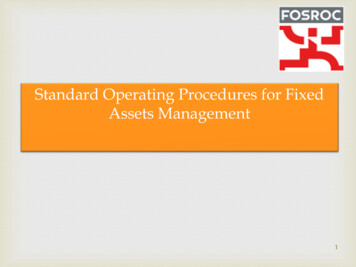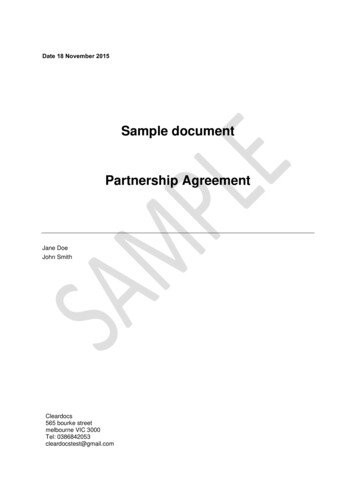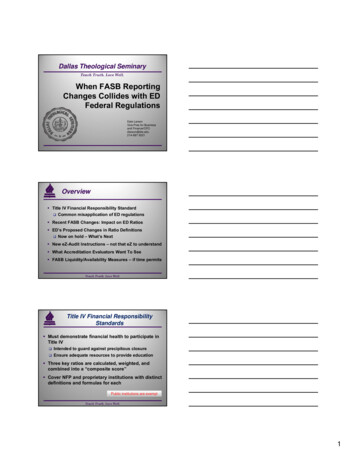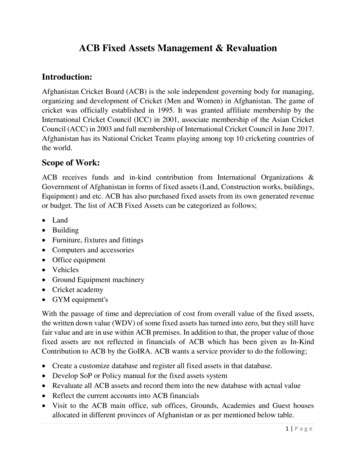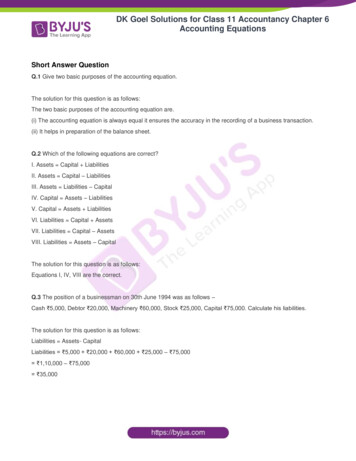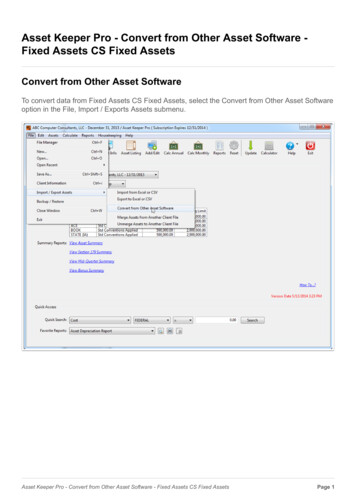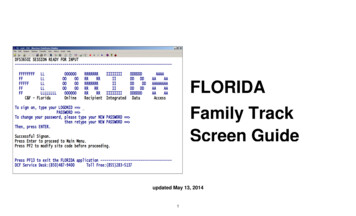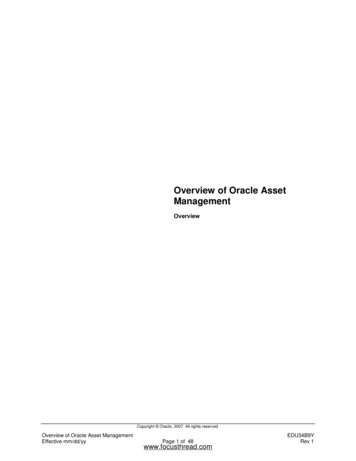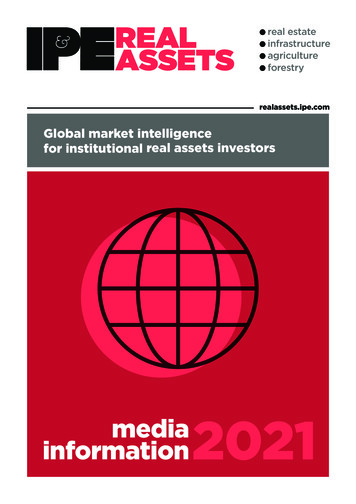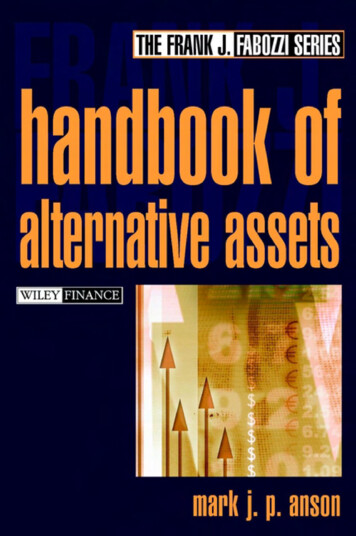
Transcription
The Handbook ofAlternative Assets
The Frank J. Fabozzi SeriesFixed Income Securities, Second Edition by Frank J. FabozziFocus on Value: A Corporate and Investor Guide to Wealth Creationby James L. Grant and James A. AbateThe Handbook of Global Fixed Income Calculations by Dragomir KrginManaging a Corporate Bond Portfolioby Leland E. Crabbe and Frank J. FabozziReal Options and Option-Embedded Securities by William T. MooreCapital Budgeting: Theory and Practiceby Pamela P. Peterson and Frank J. FabozziThe Exchange-Traded Funds Manual by Gary L. GastineauProfessional Perspectives on Fixed Income Portfolio Management, Volume 3edited by Frank J. FabozziInvesting in Emerging Fixed Income Marketsedited by Frank J. Fabozzi and Efstathia Pilarinu
The Handbook ofAlternative AssetsMark J. P. AnsonJOHN WILEY & SONS
I would like to dedicate this book to my wife, Mary Hayes,for her incredible support and indulgence;to my children Madeleine and Marcusfor playing quietly while Daddy was working on his book;and to my editor, Frank Fabozzi, for keeping me on track and on point.Copyright 2002 by Mark J.P. Anson. All rights reserved.Published by John Wiley & Sons, Inc.Published simultaneously in Canada.No part of this publication may be reproduced, stored in a retrieval system ortransmitted in any form or by any means, electronic, mechanical, photocopying,recording, scanning or otherwise, except as permitted under Sections 107 or 108of the 1976 United States Copyright Act, without either the prior written permission of the Publisher, or authorization through payment of the appropriate per-copyfee to the Copyright Clearance Center, 222 Rosewood Drive, Danvers, MA 01923,(978) 750-8400, fax (978) 750-4744. Requests to the Publisher for permissionshould be addressed to the Permissions Department, John Wiley & Sons, Inc., 605Third Avenue, New York, NY 10158-0012, (212) 850-6011, fax (212) 850-6008,E-Mail: PERMREQ@WILEY.COM.This publication is designed to provide accurate and authoritative information inregard to the subject matter covered. It is sold with the understanding that thepublisher is not engaged in rendering professional services. If professional adviceor other expert assistance is required, the services of a competent professionalperson should be sought.Wiley also publishes its books in a variety of electronic formats. Some contentthat appears in print may not be available in electronic books.ISBN: 0-471-21826-XPrinted in the United States of America.10 9 8 7 6 5 4 3 2 1
About the AuthorMark Anson is the Chief Investment Officer for the California Public Employees’Retirement System (CalPERS). CalPERS has over 151 billion in assets undermanagement. Mark earned his law degree from the Northwestern UniversitySchool of Law in Chicago where he was the Production Editor of the LawReview, and his Ph.D. and Masters in Finance from the Columbia UniversityGraduate School of Business in New York where he graduated Beta GammaSigma. Mark is a member of the New York and Illinois State Bar Associations. Hehas also earned the Chartered Financial Analyst, Certified Public Accountant,Certified Management Accountant, and Certified Internal Auditor degrees. Inaddition, Mark has received the Series 3, 4, 7, 8, 24, and 63 NASD securitiesindustry licenses. Mark is an author of two other books on the financial marketsand has published over 40 articles on the topics of hedge funds, private equity,risk management, derivatives, and portfolio management.v
PrefaceOver the past several years, I have conducted quite a bit of independentresearch with respect to the alternative asset classes discussed in thisbook. Yet, I had never stopped to consider alternative assets within acomprehensive framework. This book provides that framework.Early on, I make that statement that alternative assets are really alternative investment strategies within an existing class rather than a new asset class.This is an important point to remember because alternative assets are used moreoften to expand the investment opportunities within an existing asset class ratherthan as a hedge of that asset class.This book has two broad objectives. The first is to introduce the reader tothe various types of alternative assets that exist in the financial markets. In thisrespect, parts of this book are more descriptive in nature.In the descriptive chapters, I attempt to do away with technical financialjargon, and instead, provide examples of alternative assets that are easy to understand. When I run up against technical terms used in describing alternative assets,I provide simple examples to lay a foundation of intuition behind the jargon. Mygoal is to educate and to inform, not to dazzle the reader with my grasp of technical financial nomenclature.Second, this book provides chapters with original research with respectto alternative assets. In this respect, certain chapters are more quantitative as isnecessary to develop empirical results. Again, I try to stay away from financialjargon as much as possible and provide the intuition behind my empirical conclusions. Yet, I believe that these chapters can serve as reference material for mathematical conclusions regarding alternative assets.Overall, my goal is to provide information that has practical value to aninvestor. Therefore, this book focuses less on the theoretical development of alternative assets and more on the practical concepts needed to invest successfully. I haveused many of the concepts discussed in this book when investing in alternative assets.Finally, this book provides my ideas, research, experience, and opinionswith respect to the alternative asset industry. Undoubtedly, some readers may disagree with my thoughts, ideas, and opinions, but this is good. It means that I havestimulated the thought process of those readers to critically evaluate alternative assetsas well as my own conclusions. The greater the critical eye brought to the alternativeasset investment universe, the greater the probability of success in that universe.In sum, I hope that this book stimulates the reader with respect to alternative assets. If so, I will have considered this book to be a worthwhile effort.As a final note, this book reflects my individual opinions and insights, andnot those of my employer, the California Public Employees’ Retirement System.Mark AnsonDecember 17, 2001vii
Table of ContentsAbout the AuthorPreface1. What is an Alternative Asset Class?vvii1Section I Hedge Funds2. Introduction to Hedge Funds3. Establishing a Hedge Fund Investment Program4. Selecting a Hedge Fund Manager5. Due Diligence for Hedge Fund Managers6. Risk Management Part 1: Hedge Fund Return Distributions7. Risk Management Part II: Additional Hedge Fund Risks8. Regulation of Hedge Funds9. Should Hedge Funds Be Institutionalized?91137576993119143165Section II Commodity and Managed Futures10. Introduction to Commodities11. Investing in Commodity Futures12. Commodity Futures in a Portfolio Context13. Managed Futures175177199225241Section III Private Equity14. Introduction to Venture Capital15. Introduction to Leveraged Buyouts16. Debt as Private Equity17. The Economics of Private Equity18. Alternative Investment Strategies in Private Equity19. Performance Measurement for Private Equity259261283305333355381Section IV Credit Derivatives20. Introduction to Credit Derivatives21. Collateralized Debt Obligations407409431Section V Corporate Governance22. Corporate Governance as an Alternative Investment Strategy467469Index489ix
Chapter 1What is anAlternative Asset Class?Part of the difficulty of working with alternative asset classes is definingthem. Are they a separate asset class or a subset of an existing asset class?Do they hedge the investment opportunity set or expand it? Are they listedon an exchange or do they trade in the over-the-counter market?In most cases, alternative assets are a subset of an existing asset class.This may run contrary to the popular view that alternative assets are separate assetclasses.1 However, we take the view that what many consider separate “classes”are really just different investment strategies within an existing asset class.Additionally, in most cases, they expand the investment opportunity set,rather than hedge it. Last, alternative assets are generally purchased in the privatemarkets, outside of any exchange. While hedge funds, private equity, and creditderivatives meet these criteria, we will see that commodity futures prove to be theexception to these general rules.Alternative assets, then, are just alternative investments within an existing asset class. Specifically, most alternative assets derive their value from eitherthe debt or equity markets. For instance, most hedge fund strategies involve thepurchase and sale of either equity or debt securities. Additionally, hedge fundmanagers may invest in derivative instruments whose value is derived from theequity or debt markets.In this book, we classify five types of alternative assets: hedge funds, commodity and managed futures, private equity, credit derivatives, and corporate governance. Hedge funds and private equity are the best known of the alternative assetworld. Typically these investments are accomplished through the purchase of limited partner units in a private limited partnership. Commodity futures can be eitherpassive investing tied to a commodity futures index, or active investing through acommodity pool or advisory account. Private equity is the investment strategy ofinvesting in companies before they issue their securities publicly, or taking a publiccompany private. Credit derivatives can be purchased through limited partnershipunits, as a tranche of a special purpose vehicle, or directly through the purchase ofdistressed debt securities. Last, corporate governance is a form of shareholderactivism designed to improve the internal controls of a public company.1 See, for example, Chapter 8 in David Swensen, Pioneering Portfolio Management (New York: The FreePress, 2000).1
2What is an Alternative Asset Class?We will explore each one of these alternative asset classes in detail, providing practical advice along with useful research. We begin this chapter with areview of super asset classes.SUPER ASSET CLASSESThere are three super asset classes: capital assets, assets that are used as inputs tocreating economic value, and assets that are a store of value.2Capital AssetsCapital assets are defined by their claim on the future cash flows of an enterprise.They provide a source of ongoing value. As a result, capital assets may be valuedbased on the net present value of their expected future cash flows.Under the classic theory formulated by Franco Modigliani and MertonMiller, a corporation cannot change its value (in the absence of tax benefits) bychanging the method of its financing.3 Modigliani and Miller demonstrated thatthe value of the firm is dependent upon its cash flows. How those cash flows aredivided between their shareholders and bondholders is irrelevant to firm value.Consequently, capital assets are distinguished not by their possession ofphysical assets, but rather, by their claim on the cash flows of an underlyingenterprise. Hedge funds, private equity funds, and credit derivatives investmentsall fall within the super asset class of capital assets because their values are determined by the present value of expected future cash flows.As a result, we can conclude that it is not the types of securities in whichthey invest that distinguishes hedge funds, private equity funds, or credit derivativesfrom traditional asset classes. Rather, it is the alternative investment strategies thatthey pursue that distinguishes them from traditional stock and bond investments.Assets that Can be Used as Economic InputsCertain assets can be consumed as part of the production cycle. Consumable ortransformable assets can be converted into another asset. Generally, this class ofasset consists of the physical commodities: grains, metals, energy products, andlivestock. These assets are used as economic inputs into the production cycle toproduce other assets, such as automobiles, skyscrapers, new homes, and appliances.These assets generally cannot be valued using a net present value analysis. For example, a pound of copper, by itself, does not yield an economic streamof revenues. However, the copper can be transformed into copper piping that isused in an office building, or as part of the circuitry of an appliance.2See Robert Greer, “What is an Asset Class Anyway?” The Journal of Portfolio Management (Winter1997).3 Franco Modigliani and Merton Miller, “The Cost of Capital, Corporation Finance, and the Theory ofInvestment,” American Economic Review (June 1958).
Chapter 13While consumable assets cannot produce a stream of cash flows, we willdemonstrate in Chapter 11, which deals with commodities, that this asset classhas excellent diversification properties for an investment portfolio. In fact, thelack of dependence on future cash flows to generate value is one of the reasonswhy commodities have important diversification potential vis à vis capital assets.Assets that are a Store of ValueArt is considered the classic asset that stores value. It is not a capital assetbecause there are no cash flows associated with owning a painting or a sculpture.Consequently, art cannot be valued using a discounted cash flow analysis. It isalso not an asset that is used as an economic input because it is a finished product.Art requires ownership and possession. Its value can only be realizedthrough its sale and transfer of possession. In the meantime, the owner retains theartwork with the expectation that it will at least yield a price equal to that whichthe owner paid for it.There is no rational way to gauge whether the price of art will increase ordecrease because its value is derived purely from the subjective (and private)visual enjoyment that the right of ownership conveys. Therefore, to an owner, artis a store of value. It conveys neither economic benefits nor is used as an economic input, but retains the value paid for it.Gold and precious metals are another example of a store of value asset.In some parts of the world (India, for example), gold and silver are the primarymeans of maintaining wealth. In these countries, residents do not have access tothe same range of financial products that are available to residents of more developed nations. Consequently, they accumulate their wealth through a tangible assetas opposed to a capital asset.However, the lines between the three super classes of assets can becomeblurred. For example, gold can be leased to jewelry and other metal manufacturers. Jewelry makers lease gold during periods of seasonal demand, expecting topurchase the gold on the open market and return it to the lessor before the leaseterm ends. The gold lease provides a stream of cash flows that can be valuedusing a discounted cash flow analysis. However, the lease rate of gold is usuallysmall in relation to the market price of gold.4Precious metals can also be used as a transformable/consumable asset becausethey have the highest level of thermal and electrical conductivity amongst the metals.Silver, for example, is used in the circuitry for most telephones and light switches.Gold is used in the circuitry for TVs, cars, airplanes, computers, and rocket ships.Real EstateWe provide a brief digression to consider where real estate belongs in our classification scheme. Real estate is a distinct asset class, but is it an alternative one? For4 Forinstance, the 12-month lease rate for gold in January 2001 was 1.3375% compared to a spot price ofgold of 265 per ounce.
4What is an Alternative Asset Class?the purposes of this book we do not consider real estate to be an alternative assetclass. The reasons are several.First, real estate was an asset class long before stocks and bonds becamethe investment of choice. In fact, in times past, land was the single most important asset class. Kings, queens, lords, and nobles measured their wealth by theamount of property that they owned. “Land barons” were aptly named. Ownership of land was reserved only for the most wealthy members of society.However, over the past 200 years, our economic society changed from onebased on the ownership of property to the ownership of legal entities. This transformation occurred as society moved from the agricultural age to the industrial age.Production of goods and services became the new source of wealth and power.Stocks and bonds were born to support the financing needs of new enterprises that manufactured material goods and services. In fact, stocks and bondsbecame the “alternatives” to real estate instead of vice versa. With the advent ofstock and bond exchanges, and the general acceptance of owning equity or debtstakes in companies, it is sometimes forgotten that real estate was the original andprimary asset class of society.In fact, it was only 20 years ago in the United States that real estate wasthe major asset class of most individual investors. It was not until the long bullmarket started in 1983 that investors began to diversify their wealth into the“alternative” assets of stocks and bonds.Second, given the long-term presence of real estate as an asset class, several treatises have been written concerning its valuation.5 These treatises providea much more extensive examination of the real estate market than can be coveredwithin the scope of this book.Finally, we do not consider real estate to be an alternative asset class asmuch as we consider it to be an additional asset class. Real estate is not an alternative asset to stocks and bonds. Instead, it is a fundamental asset class thatshould be included within every diversified portfolio. The alternative assets thatwe consider in this book are meant to diversify the stock and bond holdingswithin a portfolio context.ASSET ALLOCATIONAsset allocation is generally defined as the allocation of an investor’s portfolioacross a number of asset classes. 6 Asset allocation by its very nature shifts the5 See, for example, Howard Gelbtuch, David MacKmin, and Michael Milgrim, eds., Real Estate Valuationin Global Markets (New York: Appraisal Institute, 1997); James Boykin and Alfred Ring, The Valuation ofReal Estate (Englewood Cliffs, NJ: Prentice Hall, 1993); Austin Jaffe and C.F. Sirmans, Fundamentals ofReal Estate Investment, 3d ed. (Englewood Cliffs, NJ: Prentice Hall, 1994); and Jack Cummings, RealEstate Finance & Investment Manual (Englewood Cliffs, NJ: Prentice Hall, 1997).6 See William Sharpe, “Asset Allocation: Management Style and Performance Measurement,” The Journalof Portfolio Management (Winter 1992).
Chapter 15emphasis from the security level to the portfolio level. It is an investment profilethat provides a framework for constructing a portfolio based on measures of riskand return. In this sense, asset allocation can trace its roots to Modern PortfolioTheory and the work of Harry Markowitz.7Asset Classes and Asset AllocationInitially, asset allocation involved four asset classes: equity, fixed income, cash,and real estate. Within each class, the assets could be further divided into subclasses. For example, stocks can be divided into large capitalized stocks, smallcapitalized stocks, and foreign stocks. Similarly, fixed income can be brokendown into U.S. Treasury notes and bonds, investment-grade bonds, high-yieldbonds, and sovereign bonds.The expansion of newly defined “alternative assets” may cause investorsto become confused about their diversification properties and how they fit into anoverall diversified portfolio. Investors need to understand the background of assetallocation as a concept for improving return while reducing risk.For example, in the 1980s the biggest private equity game was takingpublic companies private. Does the fact that a corporation that once had publiclytraded stock but now has privately traded stock mean that it has jumped into anew asset class? We maintain that it does not. Furthermore, public offerings arethe primary exit strategy for private equity; public ownership begins where private equity ends.8Considered within this context, a separate asset class does not need to be created for private equity. Rather this type of investment can be considered as just anotherpoint along the equity investment universe. Rather than hedging the equity class asanother separate class all together, private equity expands the equity asset class.Similarly, credit derivatives expand the fixed income asset class, ratherthan hedge it. We will also demonstrate that hedge funds can be characterized bytheir market (equity) or their fixed income (credit) exposures. Commodities fallinto a different class of assets than equity, fixed income, or cash, and will betreated separately in this book.Last, corporate governance is a strategy for investing in public companies. It seems the least likely to be an alternative investment strategy. However,we will demonstrate that a corporate governance program bears many of the samecharacteristics as other alternative investment strategies.Strategic versus Tactical AllocationsAlternative assets should be used in a tactical rather than strategic allocation.Strategic allocation of resources is applied to fundamental asset classes such as7See Harry Markowitz, Portfolio Selection (New Haven, CT: Cowles Foundation, Yale University Press,1959).8 See Jeffery Horvitz, “Asset Classes and Asset Allocation: Problems of Classification,” The Journal ofPrivate Portfolio Management (Spring 2000).
6What is an Alternative Asset Class?equity, fixed income, cash, and real estate. These are the basic asset classes thatmust be held within a diversified portfolio.Strategic asset allocation is concerned with the long-term asset mix. Thestrategic mix of assets is designed to accomplish a long-term goal such as fundingpension benefits or matching long-term liabilities. Risk aversion is consideredwhen deciding the strategic asset allocation, but current market conditions arenot. In general, policy targets are set for strategic asset classes with allowableranges around those targets. Allowable ranges are established to facilitate flexibility in the management of the investment portfolio.Tactical asset allocation is short-term in nature. This strategy is used totake advantage of current market conditions that may be more favorable to oneasset class over another. The goal of funding long-term liabilities has been satisfied by the target ranges established by the strategic asset allocation. The goal oftactical asset allocation is to maximize return.Tactical allocation of resources depends on the ability to diversify withinan asset class. This is where alternative assets have the greatest ability to addvalue. Their purpose is not to hedge the fundamental asset classes, but rather toexpand them. Consequently, alternative assets should be considered as part of abroader asset class.As already noted, private equity is simply one part of the spectrum ofequity investments. Granted, a different set of skills is required to manage a private equity portfolio compared to public equity securities. However, privateequity investments simply expand the equity investment universe. Consequently,private equity is an alternative investment strategy within the equity universe asopposed to a new fundamental asset class.Another example is credit derivatives. These are investments that expandthe frontier of credit risk investing. The fixed income world can be classified simply as a choice between U.S. Treasury securities that are considered to be defaultfree, and spread products that contain an element of credit risk. Spread productsinclude any fixed income investment that does not have a credit rating on par withthe U.S. government. Consequently, spread products trade at a credit spread relative to U.S. Treasury securities that reflects their risk of default.Credit derivatives are a way to diversify and expand the universe forinvesting in spread products. Traditionally, fixed income managers attempted toestablish their ideal credit risk and return profile by buying and selling traditionalbonds. However, the bond market can be inefficient and it may be difficult to pinpoint the exact credit profile to match the risk profile of the investor. Credit derivatives can help to plug the gaps in a fixed income portfolio, and expand the fixedincome universe by accessing credit exposure in more efficient formats.Efficient versus Inefficient Asset ClassesAnother way to distinguish alternative investment strategies is based on the efficiency of the marketplace. The U.S. public stock and bond markets are generally
Chapter 17considered to be the most efficient marketplaces in the world. Often, these markets are referred to as “semi-strong efficient.” This means that all publicly available information regarding a publicly traded corporation, both past informationand present, is fully priced in that company’s traded securities.Yet, inefficiencies exist in all markets, both public and private. If therewere no informational inefficiencies in the public equity market, there would beno case for active management. Nonetheless, inefficiencies that do exist in thepublic markets eventually dissipate. The reason is that information is easy toacquire and disseminate in the publicly traded securities markets. Top quartileactive managers in the public equity market earn excess returns (over their benchmarks) of only 1% to 2% a year.In contrast, with respect to alternative assets, information is very difficultto acquire. Most alternative assets (with the exception of commodities) are privately traded. This includes private equity, hedge funds, and credit derivatives.Consider venture capital, one subset of the private equity market. Investments in start-up companies require intense research into the product niche thecompany intends to fulfill, the background of the management of the company, projections about future cash flows, exit strategies, potential competition, beta testingschedules, and so forth. This information is not readily available to the investingpublic. It is time-consuming and expensive to accumulate. Further, most investorsdo not have the time or the talent to acquire and filter through the rough dataregarding a private company. One reason why alternative asset managers chargelarge management and incentive fees is to recoup the cost of information collection.This leads to another distinguishing factor between alternative investments and the traditional asset classes: the investment intermediary. Continuingwith our venture capital example, most investments in venture capital are madethrough limited partnerships, limited liability companies, or special purpose vehicles. It is estimated that 80% of all private equity investments in the United Statesare funneled through a financial intermediary.Last, investments in alternative assets are less liquid than their publicmarkets counterparts. Investments are closely held and liquidity is minimal. Further, without a publicly traded security, the value of private securities cannot bedetermined by market trading. The value of the private securities must be estimated by book value, appraisal, or determined by a cash flow model.OVERVIEW OF THIS BOOKThis book is organized into five sections. Section I reviews hedge funds. Chapter 2begins with a brief history on the birth of hedge funds and an introduction to thetypes of hedge fund investment strategies. Chapter 3 provides some practical guidance as to how to build a hedge fund investment program. In Chapter 4 we discussthe selection of hedge funds. Chapter 5 is devoted to conducting due diligence,
8What is an Alternative Asset Class?including both a qualitative and quantitative review. In Chapter 6 we introduce aclassification scheme for hedge funds and analyze their return distributions. InChapter 7, we consider some of the risks associated with hedge fund investing. InChapter 8 we review the regulatory framework in which hedge funds operate. Last,in Chapter 9 we consider whether hedge funds should be “institutionalized.”Section II is devoted to commodity and managed futures. We begin witha brief review in Chapter 10 of the economic value inherent in commodity futurescontracts. Chapter 11 describes how an individual or institution may invest incommodity futures, including an introduction to commodity futures benchmarks.Chapter 12 considers commodity futures within a portfolio framework, whileChapter 13 examines the managed futures industry.Section III covers the spectrum of private equity. In Chapter 14 we provide an introduction to venture capital, while Chapter 15 is devoted to leveragedbuyouts. In Chapter 16 we show how debt may be a component of the privateequity marketplace. In Chapter 17 we review the economics associated with private equity investments, and in Chapter 18 we introduce alternative investmentstrategies within the private equity marketplace. Last, we consider some issueswith respect to private equity benchmarks in Chapter 19.Section IV is devoted to credit derivatives. In Chapter 20 we review theimportance of credit risk, and provide examples of how credit derivatives areused in portfolio management. In Chapter 21 we review the collateralized debtobligation market. Specifically, we review the design, structure, and economics ofcollateralized bond obligations and collateralized loan obligations.Finally, we devote Chapter 22 to corporate governance as an alternativeinvestment strategy.Throughout this book we attempt to provide descriptive material as wellas empirical examples. Our goal is both to educate the reader with respect to thesealternative investment strategies as well as to provide a reference book.
Section IHedge Funds9
Chapter 2Introduction to Hedge FundsThe term “hedge fund” is a term of art. It is not defined in the Securities Actof 1933 or the Securities Exchange Act of 1934. Additionally
The Frank J. Fabozzi Series Fixed Income Securities, Second Edition by Frank J. Fabozzi Focus on Value: A Corporate and Investor Guide to Wealth Creation by James L. Grant and James A. Abate The Handbook of Global Fixed Income Calculations by Dragomir Krgin Managing a Corporate Bond Portfolio


